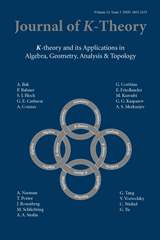Article contents
Tensor Structure on Smooth Motives
Published online by Cambridge University Press: 16 May 2011
Abstract
Recently, Bondarko constructed a DG category of motives, whose homotopy category is equivalent to Voevodsky's category of effective geometric motives, assuming resolution of singularities. Soon after, Levine extended this idea to construct a DG category whose homotopy category is equivalent to the full subcategory of motives over a base-scheme S generated by the motives of smooth projective S-schemes, assuming that S is itself smooth over a perfect field. In both constructions, the tensor structure requires ℚ-coefficients. In this article, it is shown how to provide a tensor structure on the homotopy category mentioned above, when S is semi-local and essentially smooth over a field of characteristic zero. This is done by defining a pseudo-tensor structure on the DG category of motives constructed by Levine, which induces a tensor structure on its homotopy category.
Information
- Type
- Research Article
- Information
- Copyright
- Copyright © ISOPP 2011
References
- 1
- Cited by

